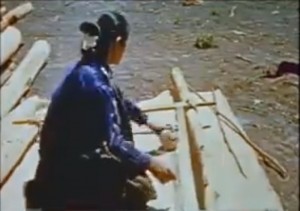"Oolichan fishing; the preparation and rendering of oil from oolichans by the Kwakiutl [First Nation]." (Camera West)
The oolichan or eulachon, sometimes known as the "candlefish," provides an oil or grease which is a historic dietary staple of the First Peoples of the Pacific Northwest.
"Marine mammals of the Pacific Coast: sea lions, sea otters, fur and harbour seals, porpoises, killer whales. Also: Indian whaling techniques; whaling ship Westwhale; processing of whale carcasses at Coal Harbour whaling station." (BC Archives)
Film includes some footage provided to Dr. Carl by the Western Whaling Corporation.

"E. Tad Nichols, III, born in the West, has been in the saddle almost since he first toddled. Much of his time has been spent among the Western Indians, and he has an intimate knowledge of their ways. So skillfully has he planned and edited each sequence of Navajo Rug Weaving that the audience has the rare satisfaction which comes from seeing just the right amount of each step of this ancient art that has held one method and course for many centuries. The direction and filming are of such excellence that the viewer almost seems to be present for the carding, spinning, dyeing and actual weaving of the rugs. Here is the human record film at its best." Movie Makers, Dec. 1945, 495.
"Un-staged documentary footage shot and edited by Sallie Wagner. Sallie's description of the film: 'Wide Ruins and area, farming Navajos, Black Rock - Medicine Man, Cut Hair plowing, Joe Toddy following Cut Hair, planting, Patsy Martin standing on Cultivator, Jim House's wife husking corn, Paul Jones helping husk corn, sheep dipping at Ganado, Dwight Wagner viewing sheep dipping, wool shearing at Wide Ruins, loading sheep at Chambers, tall man in tan outfit Bill Cousins, Bent Knee sitting on fence, Crip Chee's grandson in closing scene'." New Mexico States Archives.
"Part one of Navajo Weaving. Un-staged documentary footage shot and edited by Sallie Wagner. Sallie's description of the film: 'Crip Chee's Hogan, Milton Davis holding lamb, Eleanor Johnson from Hawaii, Bill Lippincott, Grandstaff (center), Hosteen Glish - purchase of rams for up-breeding, shearing at Wide Ruins, Jim House on horseback, Joe Toddy taking wool out for sorting and sacking for shipment, dipping in chute, Walter Ashley putting sheep in dip, Little Shorty to left, washing the wool before spinning, Patsy Martin sorting, Sybil Shorty carding wool, Dorothy Lippincott Stockton trying to learn, Louise Dale spinning wool, washing of yarn, gathering plants for dyes, Little Woman (Captive of Kit Carson - survived the Long March) grey-haired woman - stripping bark from Juniper root for red dye'." New Mexico States Archives.
"Part two of Navajo Weaving. Un-staged documentary footage shot and edited by Sallie Wagner. Sallie's description of the film: 'Rose Martin, Patsy Martin warping, Sybil Shorty weaving, looms built by the Lippincotts at the Wide Ruins Indian School, Madge Clark, Dan Gaddy, and John Joe in front of the trading post, Bill Lippincott in patio with rug display, Bill Cousins selling rug to tourist'." New Mexico State Archives.
"'Navajoland' entered by Richard V. Thiriot, of Salt Lake City, is a travelogue on that part of the great Southwest where dwell the dwindling and not-to-well-off Navajos. Thiriot has caught the beauty of this colorful country with his camera and Kodachrome film, and concludes the picture with intimate shots of some of the Indians who inhabit Navajoland. Had Thiriot been able to schedule his filming during the stormy weather season and thus been able to capture the colorful skies abounding in Navajoland at that time of the year, his photography would have greater pictorial interest, highly neccesary where subject material is predominantly static. Thiriot used a Filmo 70-DA and Kodachrome film." American Cinematographer, Apr. 1950, 145.
"Edited film by Floyd Henry Wells, a retired salesman and a member of the Wally Byam Caravan Club of Airstream trailers, chronicling travel through New Zealand including scenic views, urban scenes, beaches, Puhoi Hotel, Lyltelton and Diamond Harbors, marina, fishing, Wairakei Geyser Valley, geysers, Tehokowhitu-atu archway, Maori Reserve and indigenous peoples, and motor camping (Rainbow Springs Motor Camp)," Human Studies Film Archives, Smithsonian Museum.
"About a 9-year-old African girl, found by Protestant missionaries in the French Cameroons and reared in a mission school, who later marries a native teacher and returns to help her village." National Archives.
"Harriet Gerry shot this film during an automobile journey from Rosedale to Williams Lake and Soda Creek on the Cariboo Highway, and part of the return trip via the Dog Creek Road, in the summer of 1941" British Columbia Archives.
Total Pages: 5